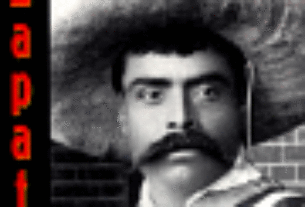(This is the second of a three-part series about Mexico’s tragic Cristero Rebellion, when forces of secular and religious fanaticism were locked in a no-quarter battle for the country’s soul.)
2: The Combat Phase
The Cristero Rebellion officially began with a manifesto issued by René Capistrán Garza on New Year’s Day 1927. Titled A la Nación (“To the Nation”), it declared that “the hour of battle has sounded” and that “the hour of victory belongs to God.” On that date the key state of Jalisco, quiescent up to now, exploded into insurrection. Throughout Los Altos ragged bands of ranchers, some armed with ancient muskets and others only with clubs, seized one village after another. These rebels faced three types of enemy formations — regular troops, agraristas (a paramilitary agrarian militia drawn from all parts of Mexico), and Social Defense forces (local collaborators who aroused fierce hatred in this Catholic heartland by siding with the government).
Despite the rebellion’s fervor, the government wasn’t too worried at first. The rebels were successful only against agraristas and Social Defense forces. When they came up against regular troops defending important population centers they were invariably defeated. As he prepared to move into rebel-held territory, Jalisco federal commander General Jesús Ferreira confidently predicted that “it will be less a campaign than a hunt.”
But the federals hadn’t counted on a phenomenon that has occurred and re-occurred throughout history: men (and women) with no military background who turn out to be natural military geniuses. Joan of Arc was a peasant girl, Cromwell a country squire and Trotsky a journalist. During the Cristero War some of the most successful rebel military leaders were Jesús Degollado (a druggist), Aristeo Pedroza and José Reyes Vega (both priests) and Victoriano Ramírez (an illiterate ranch hand). On February 23, 1927, the Cristeros broke the jinx of federal invincibility by defeating a combined Army-agrarista force at San Francisco del Rincón in the state of Guanajuato. This was followed by two more victories; the second, at San Julián, Jalisco, was gained over an elite cavalry unit.
On April 19 an event took place that almost succeeded in extinguishing the rebellion. Father José Reyes Vega led a raid against a train said to be carrying a shipment of money. In a shootout with the Army escort, Vega’s brother was killed. Maddened with rage and grief, he had the wooden cars doused with gasoline and 51 civilian passengers were burned alive. An atypical priest, Vega was known as a drinker and womanizer as well as for his murderous cruelty. (After one engagement, he had federal prisoners stabbed to death to save ammunition.)
This atrocity completely turned public opinion against the Cristeros. In Los Altos, the rebellion’s focal area, the government adopted a policy of “reconcentration,” where civilians were ordered into population centers and the countryside was declared a free-fire zone. In this manner the government could confiscate food and livestock and prevent a sympathetic civilian population from feeding the rebels. By summer of 1927 the rebellion was virtually over.
It came back to life chiefly due to the efforts of one man. Victoriano Ramírez was known as .El Catorce. (“the 14”) because he had reputedly broken out of jail and singlehandedly killed all 14 members of a posse sent to capture him. He then sent a taunting message to the mayor recommending that in the future he not pursue him with so few men. Adding spice to the story is that the mayor — a collaborator — was Victoriano’s hated uncle.
Though he could neither read nor write, El Catorce was a brilliant natural guerrilla leader. Under his leadership, the rebellion began to revive in Los Altos. Then the LNDLR finally decided to appoint an overall commander for the rebellion. Sacrificing principle to pragmatism, the man they selected was, frankly, a mercenary who took the LNDLR’s offer because he was paid almost twice the salary of a federal general. A former Army general, a liberal and Mason, Enrique Gorostieta was so alienated from Catholicism that he would even make fun of his troops’ religious observances.
One time, after capturing a town, Gorostieta led his soldiers into a church and then stretched out on a back pew and smoked a cigarette. Lack of piety did nothing to impair Gorostieta’s military skills. He formed the ragged rebel bands into disciplined troops, assigning unit numbers and awarding commissions, and bit by bit the Cristeros began to gain the upper hand. For all his moral failings, Father Vega was a born soldier, as was Father Pedroza, the other priest-commander. Unlike Vega, Pedroza was rigidly puritanical and obeyed his vows throughout the rebellion.
Throughout 1928, the Cristeros continued to dominate their enemy in the field. By early 1929, the government’s problems were further complicated when a revolt broke out within the Army. At first the Cristeros were jubilant but rejoicing was short-lived as the military rebellion was easily put down.
To make things worse, the rebels developed internal problems of their own, these centering around the flamboyant figure of Victoriano Ramirez El Catorce. A man named Mario Valdés, today widely believed to have been a federal spy, succeeded in penetrating the rebel ranks. Valdés successfully stirred up sentiment against Victoriano and he was executed following a rigged court-martial. Among charges was one that the illiterate Victoriano had written treasonable letters to a local federal commander.
Taking advantage of the military rising, the Cristeros mounted an attack on Guadalajara in late March. Though it failed, the rebels won a smashing victory at Tepatitlán, in the heart of Los Altos, on April 19. But Father Vega, who designed the plan that won victory, was killed in the engagement.
On June 2 Gorostieta died, caught in ambush by a federal patrol. However, the situation was by no means hopeless. By now, the rebels had some 50,000 men under arms and they had given ample evidence of their tenacity and zeal. In the end, the issue was decided at higher levels. The Cristero Rebellion ended not in the field but at the bargaining table and with a strong assist from some finely-honed international diplomacy.
- Part 1: Toward the Abyss
- Part 3: Behind the Scenes
- History Index -|- Time Line


